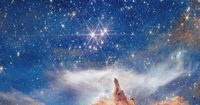On September 5, 2025, the cosmos delivered a dazzling new spectacle for astronomers and stargazers alike. NASA’s James Webb Space Telescope (JWST) unveiled a breathtaking image featuring thousands of newborn stars nestled in a dramatic cloud of dust and gas, providing a window into the universe’s most mysterious nurseries. The photograph, which has already made waves in the scientific community and beyond, not only captures the imagination but also marks a significant leap forward in humanity’s quest to understand the origins of stars and galaxies.
This latest image, released by NASA and widely reported by media outlets, showcases the heart of a nearby star-birthing center known as Pismis 24. Located some 5,500 light-years away—a staggering distance, considering that a single light-year equals 5.8 trillion miles—Pismis 24 sits deep within the so-called Lobster Nebula. The nebula itself is so vast and teeming with material that it spills beyond the camera’s field of view, its boundaries stretching into the darkness like the arms of some celestial giant.
According to NASA, the image is dotted with thousands of bright points, each representing a newly formed star emerging from the swirling gas and cosmic dust. The scene is both beautiful and scientifically invaluable, offering astronomers a rare chance to observe the early stages of stellar evolution with unprecedented clarity.
This achievement is the latest in a growing list of triumphs for the James Webb Space Telescope. Launched in December 2021, JWST represents the most ambitious space observatory ever built, a collaboration between NASA, the European Space Agency (ESA), and the Canadian Space Agency (CSA). Its mission: to peer deeper into the universe than any previous telescope, using its cutting-edge infrared vision to unveil secrets long hidden from view.
What sets JWST apart from its predecessors, such as the iconic Hubble Space Telescope, is its remarkable ability to see in the infrared spectrum. This capability allows it to look through the dense clouds of dust that often obscure star-forming regions, revealing the processes that give birth to stars and, ultimately, to planets and life itself. The telescope’s massive 6.5-meter primary mirror—much larger than Hubble’s—lets it collect more light, resulting in sharper and more detailed images.
Equipped with four advanced scientific instruments, including the Near Infrared Camera (NIRCam) and the Mid-Infrared Instrument (MIRI), JWST is a true powerhouse of astronomical discovery. These instruments allow it to conduct a wide range of observations, from examining the atmospheres of distant exoplanets to unraveling the complex chemistry of newborn stars.
The image of Pismis 24 and the Lobster Nebula took more than five hours to capture, a testament to the telescope’s patience and precision. The resulting photo reveals not only stars in a variety of sizes and colors but also the intricate structure of the nebula itself—a dramatic tapestry of interstellar material shaped by the forces of gravity and radiation.
Why does this matter? For astronomers, studying stellar nurseries like Pismis 24 is essential to understanding how stars, planets, and even galaxies come into being. The process begins when dense regions of gas and dust collapse under their own gravity, forming clumps that heat up and eventually ignite nuclear fusion. These protostars, still shrouded in their birth clouds, gradually emerge as fully fledged stars, each with its own unique properties.
According to NASA, observing these early stages sheds light on the very mechanisms that drive cosmic evolution. By analyzing the chemical composition of newborn stars, scientists can infer the conditions that existed in the early universe and, perhaps, the ingredients necessary for life to arise elsewhere. As the agency explains, "Studying newborn stars helps scientists understand the star formation process, the chemical composition of celestial bodies, and the evolution of galaxies, all of which are critical for understanding the universe."
The Lobster Nebula, the dramatic backdrop for this latest image, is a particularly fertile region for star formation. Its swirling clouds of gas and dust serve as both cradle and cocoon, nurturing new stars while also shaping their development. The nebula’s sheer size—so immense that it can’t be fully contained in a single shot—speaks to the vastness of the forces at work.
But JWST’s contributions extend far beyond just this one image. Since its launch, the telescope has been instrumental in advancing our knowledge of the cosmos on several fronts. For instance, it has enabled detailed studies of exoplanets—planets orbiting stars outside our solar system—by analyzing the light that passes through their atmospheres. In 2022, JWST made headlines by detecting carbon dioxide in the atmosphere of the exoplanet WASP-39 b, a discovery that brought scientists one step closer to identifying potentially habitable worlds.
The telescope has also pushed the boundaries of what we know about distant galaxies. By capturing light from galaxies that formed just a few hundred million years after the Big Bang, JWST offers a glimpse into the universe’s earliest chapters. These observations help astronomers piece together the story of how galaxies grow, merge, and evolve over billions of years.
In addition, JWST’s data is proving invaluable in the ongoing quest to understand dark matter and dark energy—the mysterious substances that together make up most of the universe’s mass and energy. By studying phenomena like gravitational lensing, where massive objects bend the light from more distant sources, the telescope is helping scientists map the distribution of dark matter and probe the nature of dark energy.
All of these discoveries are made possible by an unprecedented level of international cooperation. The JWST project brought together scientists and engineers from across the globe, pooling resources and expertise to create a telescope capable of transforming our view of the universe. According to NASA, ESA, and CSA, this spirit of collaboration is vital to tackling the most profound questions in astronomy.
Importantly, the public can share in these discoveries. NASA has made JWST’s images and data freely available on its website, allowing anyone with an internet connection to explore the wonders of space. This commitment to open access reflects the agency’s broader mission to inspire the next generation of scientists and engineers. Educational resources and outreach programs built around JWST’s findings aim to spark curiosity and foster a deeper appreciation of the cosmos.
As the James Webb Space Telescope continues its mission, astronomers anticipate even more groundbreaking discoveries. Future projects include detailed studies of exoplanet atmospheres, deeper explorations of star and galaxy formation, and investigations into the conditions that prevailed shortly after the Big Bang. Each new image and dataset not only advances scientific knowledge but also reminds us of the beauty and complexity of the universe we inhabit.
With every revelation, JWST affirms its place as a cornerstone of modern astronomy—a testament to human ingenuity and our enduring desire to explore the unknown. The latest snapshot of thousands of newborn stars is more than just a pretty picture; it’s a beacon guiding us toward the next great frontier in our understanding of the cosmos.

